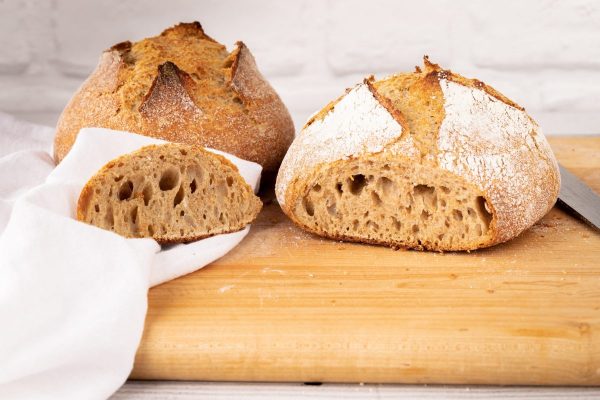Ingredients
- 4 1/2 sticks butter (unsalted)
- 1 recipe croissant dough well (chilled)
- 1 flour for rolling dough
- 1 egg
- 450 gr flour
- 240 ml milk
- 65 gr sugar
- 28 gr yeast (fresh)
- 16 gr flour
- 6 gr salt
FOR THE DOUGH: Put the yeast, flour sugar, salt and 1 cup of milk into the bowl of a mixer fitted with a dough hook. With the machine on its lowest speed, mix for 1 to 2 minutes, until a soft, moist dough forms on the hook. If the dough is to dry, add more milk, 1 tablespoon at a time. In most cases if the dough does need more liquid, it won't need more than about 3 tablespoons, but check carefully as you want all the flour to be moistened. Stop the mixer and look into the bowl. If the hook has not picked up all the flour from the bottom af the bowl, add a few more drops of milk. Set ther mixer to its highest speed and work the dough until it is smooth and elastic, no longer sticky and close to the consistancy of soft butter, about 4 minutes. To make certain that all the ingredients are perfectly blendedyou can remove the dough from the mixer after 3 minutes, and then with the mixer on high speed, return plum size pieces to the bowl. The pieces will remain seperate for a short while, then come together, at which time the dough is ready. Remove the dough from the mixer, wrap it in plastic and put it in a plastic bag, leaving a little room for expansion. Keep the dough at room temperature for 30 minutes to give the gluten time to relax; then refrigerate the dough for 8 hours or ovenight. FOR THE BUTTER: Attach the paddle to your mixer and beat the butter and flour on the highest speed until smooth and the same consistency as the croissant dough, about 2 minutes. Reach into the bowl and poke around in the butter to make sure that its evenly blended-if you find any lumps, just squeeze them between your fingers. Scrape the butter onto a large piece of plastic wrap and give it a few slaps to knock the air out of it. Mold it into an oval 5 to 15 cm long and 3 cm thick, Wrap it tightly and refrigerate until needed. At this point the dough and the butter can be frozen; defrost overnight in the refrigerator before preceeding with the recipe. INCORPORATING THE BUTTER: Place the croissant doughon a generously floured large work surface (marble is ideal(sure!!!)) and sprinkle the top of the dough lightly with flour. Using a long rolling pin, roll the dough into an oval approximately 25 cm wide and 43 cm long. Brush the excess flour from the dough. Center the oval of chilled butter across the oval of dough and fold the top and bottom of the dough over the butter to make a tidy package. Gently and evenly stretch the folded layers of dough out to ther sides and press the edges down firmly with your fingertips to create a neatly sealed rectangle. If you own a French rolling pin (one without handles)now's the time to use it. Hold one side of the doughsteady with your hand and strike the other side gently but firmly with the rolling pin to distribute the butter evenly. As you hit the doough you will see the butter moving out into the crevises. Strike the other side of the dough the same way. After pounding you should have a 3 cm thick rectangle about about 36 cm long and 15 cm wide. Keeping the work surface and the top of the dough well floured, roll out the dough. If this your first time working with croissant dough, you may want to roll out the dough just a little to distribute the butter, put it on a baking sheet lined with flour-dusted parchment paper, cover it with plastic and chill it for 1 to 2 hoours first; this way you won't risk having the dough go soft or the butter seep out. (Each time you wrap the dough, make sure it's well covered-even a little air will cause the dought to form an unwanted skin.) If your experienced, feeling courageous or have dough that is still well chilled, go on to make your first turn. ROLLING AND FOLDING: Roll the dough into a rectangle 24 to 66 cm long and about 36 cm wide, with the long side facing you. (You may feel as though your rolling the dough sideways-and you are.) Brush off the excess flourand, working from the left and right sides, fold the dough inward into thirds, as you would a brochure, so that you have a package that's about 20 cm wide by 36 cm long. Carefully transfer the dough to a parchmentlined baking sheet, mark the parchment "1 turn" so you'll know what you've done, cover and refrigerate for at least 2 hours. You can frereze the dough after this ar any other turn. Thaw overnight in the refrigerator before proceeding. FOR THE SECOND TURN: Place the dough so that the 36 cm side runs left to right. (The dough needs 2 more turns; you've given it one quarter-turn already.) Making sure the work surface is well floured at all times, roll the dough as you did before into a rectangle 24 to 66 cm long by about 36 cm wide . (When doing the second and third turns, you may find that the dough has cracked a little. That's natural; it's a result of the yeast. Don't worry, just flour the dough and work surface and keep going.) As you did before fold the dough in thirds. Place it on the parchment, mark the paper "2 turns", cover and refrigerate for at least 2 hours. FOR THE THIRD TURN: Start agian with a 36 cm side running from your left side ti your right. Roll the dough into a rectangle 24 to 66 cm long by 36 cm wide. Fold the left and right sides of the dough into the center, leaving a little space in the centrer, and then fold one side over the other as though you were closing a book. This is the famouse double turn, also known as "the wallet". Chilling the dough: Brush off the flour, wrap the dough in plastic and refrigerate for 2 hours. At this point the dough is ready to be rolled, cut and shaped into croissants. Storring: The dough can be frozen for up to 1 month. Thaw overnight, still wrapped, in the refrigerator. CROISSANTS ROLLING THE DOUGH: Generously flour a work surface. Position the dough so that it resembles a book, with the spine to your left and the opening to your right. For easy handling, cut the dough in half horizontally so that you have two pieces about 18 cm long and about 17 cm wide: wrap and chill one half while you work with the other half. Flour the dough and roll it into a rectangle that's 24 to 66 cm long and 15 to 46 cm wide. This takes a lot of rolling. Keep the work surface and the dough well floured and have patience. If necessary turn the dough so that the long side runs from left to right along the counter. Carefully fold the top half of the dough down to the bottom. The dough is now ready for cutting. CUTTING THE DOUGH: Working with a pizza cutter or a large, very sharp knife, cut triangles from the dough. This is done most easily by making a diagonal cut on the left hand side to geet the pattern started; save the uneven piece of dough. MEasure off a 3 to 10 cm base and begin cutting the triangles, always cutting from bottom to top. You'll have another scrap when you reach the other end-you'll use these scraps when you shape the croissants. Unfold each pair of triangles and cut them in half to seperate. You should have 10 to dozen maybe 14 triangles; set them aside while you clear the work surface of all flour. Line two large baking sheets with parchment paper. SHAPING THE CROISSANTS: Moisten your hands with a wet towel. Working with one triangle at a time, gently stretch the base to widen it slightly, then, holding the base of the triangle in one hand, run the fingers of the other hand down to the point of the triangle. Use your thumb to pull and stretch the dough until it's almos twice the original length-have courage and tug; the extra length is what allows you to make a large croissant with sufficient rolls to show off it's layers of dough. Place the treiangle, point toward you, at arm distance on the work table this will give enough space to roll the croissant into shape with-out having to lift it in mid-roll) Pull off a little piece of the reserved scrap dough, mold it into a small football shape and center it on the wide top part of the triangle-this will help make the "belly" of the croissant plump. Fold about 1 cm of this wide end over itself and press the ends down once to secure. With you palms and fingers positioned over the flattened ends of the croissant and the heels of your hands on the flat work surface, roll the croissant toward you-try to keep your hands moving down and out to the sides as you rollending with the point of the triangle tucked under the croissant. A well shaped croissant-and it takes practice to achieve one-will sport at least six clearly accountable sections, or ridges, from rolling. Place the croissants on one of the baking sheets, leaving room for them to triple in size without touching one another. Repeat with the other half of the dough. Glazing and rising: Give the croiossants a last gentle plumping, carrefully turning the ends down and toward the center to produce the classic croissant shape. Brush the croissants with egg wash and allow them to rise, uncovered, at room temperature for 3 to 4 hours, until tripled in size and spongy. (Reserve egg wash, covered in the refrigerator.) The ideal place for rising is a turned off oven (one with a pilot light is fine) containing a pan of hot steamy water. To test that they are properly risen, wet your fingers and squeeze the end of a croissant:It should offer no resistance and feel almost hollow. Baking the croissants: Arrange the oven racks to divide the oven into thirds, and preheat the oven to 180ºC . Brush the croissants once again with egg wash and bake for dozen minutes. Rotate front to back and bake another 4 to 6 minutes, until the croissants are deeply bronzed. Cool on racks. As tempting as they are croissants should not be eaten as soon as they come from the oven. The dough-and the layers within need time to set.



